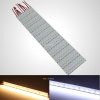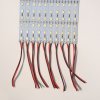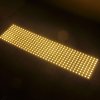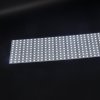liesandlies
Active Member
(adding the info a bit at a time..)
This is kind of written at a level of near beginner to a somewhat familiar with the topic. Most of the numbers are rounded to 2 digits, and useful at the scale they're given for. This is just for general info.
disclaimer - I have no experience and very little understanding of the numbers and electrical-side... just going from documented measurements, and best guesses. also, any wiring techniques are just ideas. have fun, be safe
5630, compared to 5050 and 3528

http://heracolights.com/2014/03/10/3528-vs-5050-vs-5630-led-smd-diodes/

5630 .. 45-50 lumens per led .. 150 mA (2.8-3.4 Volts) = .42-.51 watts
5050 .. 16-22 lumens per led .. 60 mA (2.8-3.4 Volts) = .17-.26 watts
3528 .. 6-8 lumens per led .. 20-30 mA (2.8-3.4 Volts) = .05-.08 watts
The 3528 and the 5630 produce 100 lumens per watt. The 5050 produces 90 lumens per watt. The efficiency is similar. The difference is in the intensity; brightness; the amount of lumens emitted from each led.
The 5630 emits ~2.5 times as much light as the 5050, per led, from a slightly smaller surface area.
Wattage decrease over distance:
The thin copper film on the SMD strips has a lot of electrical resistance(impedance). That resistance causes the voltage to decrease, and thus the wattage decreases. The longer the distance of the strip, the more the voltage decreases, and the less watts go to the leds. So the led's at the end of a long strip will be less bright.
Some led strips or strings use wire, instead of thin copper film, and these should result in much less wattage decrease.
Some measurements (all using 12v, all from SMD strips):
A 5050 5m strip was measured
At full 5m = 30w (0.1w / led).
Cut to 1m = 10w (0.18w/led)
5 other 5050 5m strips have been measured at 35w.
A 5630 5m strip was measured at 41w.
A 5050 .5m (36led) strip was measured, and then more were connected in series (daisy-chain) and the wattage measured again. (The watts listed are for each additional strip)
1 .5m strip = 10w .. .27w per led .. (all combined = 10w = .27w / led)
2 .5m (1m) = 7w .. .19w per led .. (all combined = 17w = .24w / led)
3 (1.5m) = 5w .. .14w per led .. (all combined = 22w = .21w / led)
4 .5m 2m = 3w .. .03w per led .. (all combined = 25w = .17w / led)
5 (2.5m) = 1w .. .02w per led .. (all combined = 26w = .14w / led)
So
Different ways to Power a Strip to Reduce Voltage Drop
Strip =======
pos and neg (+) (-)
the usual way of wiring a strip is connecting a positive and a negative to one end
(+-)=======
(the voltage loss (light dimming) grows towards the far end)
Powering a 1m strip this way will supply the wattage of powering a 1m strip.
a strip can also be powered with the positive at one end and the negative at the other end
(+)========(-)
(supposed to give the same amount of power as the usual way, however the voltage loss happens in the middle, instead of at the far end)
Powering a 1m strip this way will supply the wattage of powering a 1m strip.
dual-feed, double feed is when it is connected to a positive and a negative, at both ends
(+-)========(+-)
(supposed to give the same available power as powering 2 strips separate, with the voltage loss in the middle)
Powering a 1m strip this way will supply the wattage of powering 2 .5m strips separately. (the available wattage can only be utilized up to a strips max wattage)
powered from the middle
========(+-)=======
(supposed to be equal to powering 2 strips separately)
Powering a 1m strip this way will supply the wattage of powering 2 .5m strips separately. (the available wattage can only be utilized up to a strips max wattage)
A few examples to compare..
(+-)======== ========(+-)
would make available the same wattage as
(+-)================(+-)
and the same as
========(+-)========
This is kind of written at a level of near beginner to a somewhat familiar with the topic. Most of the numbers are rounded to 2 digits, and useful at the scale they're given for. This is just for general info.
disclaimer - I have no experience and very little understanding of the numbers and electrical-side... just going from documented measurements, and best guesses. also, any wiring techniques are just ideas. have fun, be safe
5630, compared to 5050 and 3528

http://heracolights.com/2014/03/10/3528-vs-5050-vs-5630-led-smd-diodes/

5630 .. 45-50 lumens per led .. 150 mA (2.8-3.4 Volts) = .42-.51 watts
5050 .. 16-22 lumens per led .. 60 mA (2.8-3.4 Volts) = .17-.26 watts
3528 .. 6-8 lumens per led .. 20-30 mA (2.8-3.4 Volts) = .05-.08 watts
The 3528 and the 5630 produce 100 lumens per watt. The 5050 produces 90 lumens per watt. The efficiency is similar. The difference is in the intensity; brightness; the amount of lumens emitted from each led.
The 5630 emits ~2.5 times as much light as the 5050, per led, from a slightly smaller surface area.
Wattage decrease over distance:
The thin copper film on the SMD strips has a lot of electrical resistance(impedance). That resistance causes the voltage to decrease, and thus the wattage decreases. The longer the distance of the strip, the more the voltage decreases, and the less watts go to the leds. So the led's at the end of a long strip will be less bright.
Some led strips or strings use wire, instead of thin copper film, and these should result in much less wattage decrease.
Some measurements (all using 12v, all from SMD strips):
A 5050 5m strip was measured
At full 5m = 30w (0.1w / led).
Cut to 1m = 10w (0.18w/led)
5 other 5050 5m strips have been measured at 35w.
A 5630 5m strip was measured at 41w.
A 5050 .5m (36led) strip was measured, and then more were connected in series (daisy-chain) and the wattage measured again. (The watts listed are for each additional strip)
1 .5m strip = 10w .. .27w per led .. (all combined = 10w = .27w / led)
2 .5m (1m) = 7w .. .19w per led .. (all combined = 17w = .24w / led)
3 (1.5m) = 5w .. .14w per led .. (all combined = 22w = .21w / led)
4 .5m 2m = 3w .. .03w per led .. (all combined = 25w = .17w / led)
5 (2.5m) = 1w .. .02w per led .. (all combined = 26w = .14w / led)
So
Different ways to Power a Strip to Reduce Voltage Drop
Strip =======
pos and neg (+) (-)
the usual way of wiring a strip is connecting a positive and a negative to one end
(+-)=======
(the voltage loss (light dimming) grows towards the far end)
Powering a 1m strip this way will supply the wattage of powering a 1m strip.
a strip can also be powered with the positive at one end and the negative at the other end
(+)========(-)
(supposed to give the same amount of power as the usual way, however the voltage loss happens in the middle, instead of at the far end)
Powering a 1m strip this way will supply the wattage of powering a 1m strip.
dual-feed, double feed is when it is connected to a positive and a negative, at both ends
(+-)========(+-)
(supposed to give the same available power as powering 2 strips separate, with the voltage loss in the middle)
Powering a 1m strip this way will supply the wattage of powering 2 .5m strips separately. (the available wattage can only be utilized up to a strips max wattage)
powered from the middle
========(+-)=======
(supposed to be equal to powering 2 strips separately)
Powering a 1m strip this way will supply the wattage of powering 2 .5m strips separately. (the available wattage can only be utilized up to a strips max wattage)
A few examples to compare..
(+-)======== ========(+-)
would make available the same wattage as
(+-)================(+-)
and the same as
========(+-)========
Last edited:










